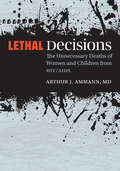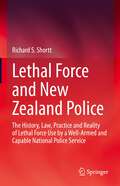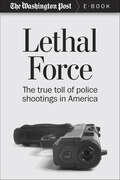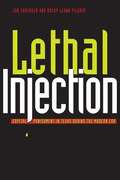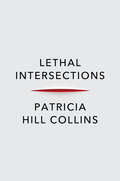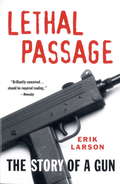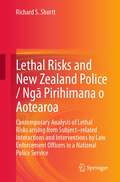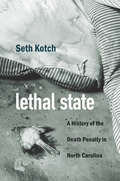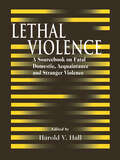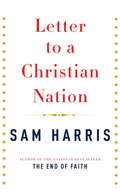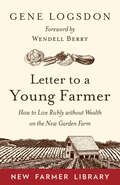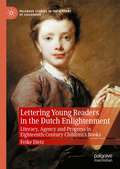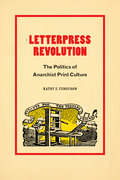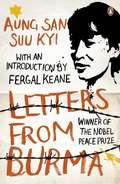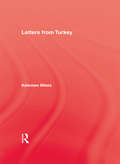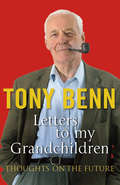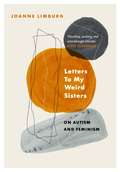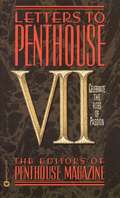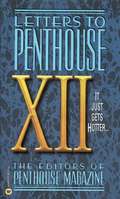- Table View
- List View
Lethal Decisions: The Unnecessary Deaths of Women and Children from HIV/AIDS
by Arthur J. AmmannThis first-person account by one of the pioneers of HIV/AIDS research chronicles the interaction among the pediatric HIV/AIDS community, regulatory bodies, governments, and activists over more than three decades. After the discovery of AIDS in a handful of infants in 1981, the next fifteen years showed remarkable scientific progress in prevention and treatment, although blood banks, drug companies, and bureaucrats were often slow to act. 1996 was a watershed year when scientific and clinical HIV experts called for treating all HIV-infected individuals with potent triple combinations of antiretroviral drugs that had been proven effective. Aggressive implementation of prevention and treatment in the United States led to marked declines in the number of HIV-related deaths, fewer new infections and hospital visits, and fewer than one hundred infants born infected each year.Inexplicably, the World Health Organization recommended withholding treatment for the majority of HIV-infected individuals in poor countries, and clinical researchers embarked on studies to evaluate inferior treatment approaches even while the pandemic continued to claim the lives of millions of women and children. Why did it take an additional twenty years for international health organizations to recommend the treatment and prevention measures that had had such a profound impact on the pandemic in wealthy countries? The surprising answers are likely to be debated by medical historians and ethicists.At last, in 2015, came a universal call for treating all HIV-infected individuals with triple-combination antiretroviral drugs. But this can only be accomplished if the mistakes of the past are rectified. The book ends with recommendations on how the pediatric HIV/AIDS epidemic can finally be brought to an end.
Lethal Decisions: The Unnecessary Deaths of Women and Children from HIV/AIDS
by Arthur J. AmmannThis first-person account by one of the pioneers of HIV/AIDS research chronicles the interaction among the pediatric HIV/AIDS community, regulatory bodies, governments, and activists over more than three decades. After the discovery of AIDS in a handful of infants in 1981, the next fifteen years showed remarkable scientific progress in prevention and treatment, although blood banks, drug companies, and bureaucrats were often slow to act. 1996 was a watershed year when scientific and clinical HIV experts called for treating all HIV-infected individuals with potent triple combinations of antiretroviral drugs that had been proven effective. Aggressive implementation of prevention and treatment in the United States led to marked declines in the number of HIV-related deaths, fewer new infections and hospital visits, and fewer than one hundred infants born infected each year. Inexplicably, the World Health Organization recommended withholding treatment for the majority of HIV-infected individuals in poor countries, and clinical researchers embarked on studies to evaluate inferior treatment approaches even while the pandemic continued to claim the lives of millions of women and children. Why did it take an additional twenty years for international health organizations to recommend the treatment and prevention measures that had had such a profound impact on the pandemic in wealthy countries? The surprising answers are likely to be debated by medical historians and ethicists. At last, in 2015, came a universal call for treating all HIV-infected individuals with triple-combination antiretroviral drugs. But this can only be accomplished if the mistakes of the past are rectified. The book ends with recommendations on how the pediatric HIV/AIDS epidemic can finally be brought to an end.
Lethal Force and New Zealand Police: The History, Law, Practice and Reality of Lethal Force Use by a Well-Armed and Capable National Police Service
by Richard S. ShorttThis book challenges the notion that the New Zealand Police are one of only four global police services that does not have routinely armed officers, using arguments and facts drawn from 2000 to 2019, a period of important change for the organisation and its relationship with firearms, particularly following the outrages of the Christchurch mosques terrorist massacres in 2019, and the 2020 shooting death of a young police constable in Aotearoa New Zealand. This book provides a brief history of the Police from its beginnings to the present day with a specific focus on its relationship with firearms, which contextualize the law that justifies use of lethal force in a country that has abolished the death penalty. It examines police policies, procedures, training and structures governing deployment and use of firearms in Aotearoa New Zealand, and the independent oversight that now applies to fatal and non-fatal shootings by Police. Using 43 publicly released oversight agency reports and data directly related to police shootings, such as who is being shot, this book investigates how the police are using lethal force, who is being affected, and what this might mean for the service with regards to the operational deployment of firearms and the potential for use of lethal force within the community into the future.
Lethal Force: The True Toll of Police Shootings in America
by The Washington PostIn 2015, The Washington Post launched an unprecedented effort to account for every fatal shooting by an officer of the law. Their study has motivated the FBI to action, and changed the way we think of those who serve and protect. After a police officer shot and killed a black teenager in Ferguson, Missouri, the media began to pay greater attention to deadly interactions between black men and the law. But when reporters tried to get to the bottom of some basic questions—how often do police shoot people? Who are the victims? Are officers ever charged with crimes?—they came up blank. Police departments were not required to report these statistics to the FBI.The Washington Post set out to track every fatal shooting by an on-duty officer in 2015. Its database chronicled the shootings in real time, using news reports and other public sources. It compiled a trove of data, from the race of the person killed, whether the person was armed when killed, to whether the person was purported to have threatened the officer prior to being killed. The results found by the Post are shocking and haunting, from the sheer breadth of shootings by police in the U.S. to the stories of those killed. And its call to reform is being heeded. This groundbreaking book will radically alter how you view confrontation and accountability within the ranks, and offer a new perspective going forward.
Lethal Injection: Capital Punishment in Texas during the Modern Era
by LeAnn Jon Sorensen Rocky Pilgrim Mandery Evan J.Few state issues have attracted as much controversy and national attention as the application of the death penalty in Texas. In the years since the death penalty was reinstated in 1976, Texas has led the nation in passing death sentences and executing prisoners. The vigor with which Texas has implemented capital punishment has, however, raised more than a few questions.
Lethal Intersections: Race, Gender, and Violence
by Patricia Hill CollinsSchool shootings, police misconduct, and sexual assault where people are injured and die dominate the news. What are the connections between such incidents of violence and extreme harm? In this new book, world-renowned sociologist Patricia Hill Collins explores how violence differentially affects people according to their class, sexuality, nationality, and ethnicity. These invisible workings of overlapping power relations give rise to what she terms “lethal intersections,” where multiple forms of oppression converge to catalyze a set of violent practices that fall more heavily on particular groups. Drawing on a rich tapestry of cases, Collins challenges readers to reflect on what counts as violence today and what can be done about it. Resisting violence offers a common thread that weaves together disparate antiviolence projects across the world. When parents of murdered children organize against gun violence, when Black citizens march against the excessive use of police force in their neighborhoods, and when women and girls report sexual abuse by employers, coaches, and community leaders, the ideas and actions of ordinary people lay a foundation for new ways of thinking about and combating violence. Through its ground-breaking analysis, Lethal Intersections aims to stimulate debate about violence as one of the most pressing social problems of our times.
Lethal Legacy: Current Native Controversies in Canada
by J. R. MillerCanadians greeted the disruptions in Native-newcomer relations that occasionally erupted during the 1990s with incomprehension. Politicians, journalists, and ordinary citizens understood neither how nor why the crisis of the moment had arisen, much less how its deep historical roots made it resistant to solutions. J.R. Miller believes that it takes a historical understanding of public policy affecting Canadian Natives to truly comprehend the issues and their ramifications. An expert on indigenous-newcomer relations, Miller uses his extensive research from conventional and Native sources to explore and explain the controversial issues facing Canadian Natives today. In five sections this book covers topics such as Native identity, self-government, treaties, attitudes to land and ownership, and assimilation. Miller acknowledges the fact that there are no easy solutions, but argues that greater understanding is the foundation for building successful relations between Natives and non-Natives in Canada.
Lethal Passage: The Story of a Gun
by Erik LarsonThis devastating book illuminates America's gun culture -- its manufacturers, dealers, buffs, and propagandists -- but also offers concrete solutions to our national epidemic of death by firearm. It begins with an account of a crime that is by now almost commonplace: on December 16, 1988, sixteen-year-old Nicholas Elliot walked into his Virginia high school with a Cobray M-11/9 and several hundred rounds of ammunition tucked in his backpack. By day's end, he had killed one teacher and severely wounded another.In Lethal Passage Erik Larson shows us how a disturbed teenager was able to buy a weapon advertised as "the gun that made the eighties roar." The result is a book that can -- and should -- save lives, and that has already become an essential text in the gun-control debate.With a new afterword."Touches on all aspects of the gun issue in this country. Gives great voice to that feeling...that something real must be done." --San Diego Union-Tribune"One of the most readable anti-gun treatises in years." --Washington Post Book World
Lethal Risks and New Zealand Police / Ngā Pirihimana o Aotearoa: Contemporary Analysis of Lethal Risks arising from Subject–related Interactions and Interventions by Law Enforcement Officers in a National Police Service
by Richard S. ShorttThis book examines the lethal risks faced by police and traffic officers in Aotearoa New Zealand. It tracks lethal risk volume and type across 134 years of the New Zealand Police/Ngā Pirihimana o Aotearoa’s 137-year existence. Using data gathered from public records, official government reporting, and comparative studies, it reveals the current situation with regards to lethal risks from 1886 to 2019. The book identifies and presents two lethal risk hierarchies, the first for the period 1886-1999 and the second for the period 2000-2019. The hierarchies establish that the lethal risks faced come from: • Firearms • Assaults • And, potentially, Cutting/Stabbing attacks It determines that the nature of lethal risk has not changed, but rather the volume has reduced, meaning today’s officers are less likely to be harmed by lethal risk encounters than their predecessors were. This volume is an ideal starting point for researchers and practitioners interested in developing further scholarly research on lethal force and lethal risks faced by law enforcement officers and the organization they belong to.
Lethal State: A History of the Death Penalty in North Carolina (Justice, Power, and Politics)
by Seth KotchFor years, American states have tinkered with the machinery of death, seeking to align capital punishment with evolving social standards and public will. Against this backdrop, North Carolina had long stood out as a prolific executioner with harsh mandatory sentencing statutes. But as the state sought to remake its image as modern and business-progressive in the early twentieth century, the question of execution preoccupied lawmakers, reformers, and state boosters alike.In this book, Seth Kotch recounts the history of the death penalty in North Carolina from its colonial origins to the present. He tracks the attempts to reform and sanitize the administration of death in a state as dedicated to its image as it was to rigid racial hierarchies. Through this lens, Lethal State helps explain not only Americans' deep and growing uncertainty about the death penalty but also their commitment to it. Kotch argues that Jim Crow justice continued to reign in the guise of a modernizing, orderly state and offers essential insight into the relationship between race, violence, and power in North Carolina. The history of capital punishment in North Carolina, as in other states wrestling with similar issues, emerges as one of state-building through lethal punishment.
Lethal Violence: A Sourcebook on Fatal Domestic, Acquaintance and Stranger Violence
by Harold V. HallLethal Violence: A Sourcebook on Fatal Domestic, Acquaintance and Stranger Aggression applies the lethal violence sequence analysis to a wide-ranging array of fatal aggression, resulting in a multitude of observations and principles of violence. This sourcebook provides base rate information and cases for each type of fatal interaction, then applies the knowledge to violence-related situations and settings.
Letter to a Christian Nation
by Sam Harris“Thousands of people have written to tell me that I am wrong not to believe in God. The most hostile of these communications have come from Christians. This is ironic, as Christians generally imagine that no faith imparts the virtues of love and forgiveness more effectively than their own. The truth is that many who claim to be transformed by Christ’s love are deeply, even murderously, intolerant of criticism. While we may want to ascribe this to human nature, it is clear that such hatred draws considerable support from the Bible. How do I know this? The most disturbed of my correspondents always cite chapter and verse. ” So beginsLetter to a Christian Nation… www. samharris. org From the Hardcover edition.
Letter to a Christian Nation
by Sam HarrisFrom the new afterword by the author:Humanity has had a long fascination with blood sacrifice. In fact, it has been by no means uncommon for a child to be born into this world only to be patiently and lovingly reared by religious maniacs, who believe that the best way to keep the sun on its course or to ensure a rich harvest is to lead him by tender hand into a field or to a mountaintop and bury, butcher, or burn him alive as offering to an invisible God. The notion that Jesus Christ died for our sins and that his death constitutes a successful propitiation of a "loving" God is a direct and undisguised inheritance of the superstitious bloodletting that has plagued bewildered people throughout history. . .From the Trade Paperback edition.
Letter to a Young Farmer: How to Live Richly without Wealth on the New Garden Farm
by Gene Logsdon&“In the midst of our epidemic fear of the future and its so-far predicted emergencies and catastrophes, here is Gene patiently, quietly, with the right touch of merriment, talking about the small, really possible ways of solving our one great problem: how to live on the Earth without destroying it.&”—Wendell Berry, from the forewordFor more than four decades, the self-described &“contrary farmer&” and writer Gene Logsdon has commented on the state of American agriculture. In Letter to a Young Farmer, his final book of essays, Logsdon addresses the next generation—young people who are moving back to the land to enjoy a better way of life as small-scale &“garden farmers.&” It&’s a lifestyle that isn&’t defined by accumulating wealth or by the &“get big or get out&” agribusiness mindset. Instead, it&’s one that recognizes the beauty of nature, cherishes the land, respects our fellow creatures, and values rural traditions. It&’s one that also looks forward and embraces &“right technologies,&” including new and innovative ways of working smarter, not harder, and avoiding premature burnout.Completed only a few weeks before the author&’s death, Letter to a Young Farmer is a remarkable testament to the life and wisdom of one of the greatest rural philosophers and writers of our time. Gene&’s earthy wit and sometimes irreverent humor combines with his valuable perspectives on many wide-ranging subjects—everything from how to show a ram who&’s boss to enjoying the almost churchlike calmness of a well-built livestock barn.Reading this book is like sitting down on the porch with a neighbor who has learned the ways of farming through years of long observation and practice. Someone, in short, who has &“seen it all&” and has much to say, and much to teach us, if we only take the time to listen and learn. And Gene Logsdon was the best kind of teacher: equal parts storyteller, idealist, and rabble-rouser. His vision of a nation filled with garden farmers, based in cities, towns, and countrysides, will resonate with many people, both young and old, who long to create a more sustainable, meaningful life for themselves and a better world for all of us.&“Sagacious and sly, practical and poetic, Logsdon&’s voice may have been contrarian but it was never condescending.&”—Booklist
Lettere per un Fratello Immigrante
by Franklin A. Díaz LárezHai mai pensato di lasciare il tuo paese? Stai pensando di lasciarti tutto alle spalle per iniziare una nuova vita in un'altra parte del mondo Sai perfettamente ciò a cui vai incontro? Un testo scritto in forma di lettere destinate a un fratello che sogna di emigrare. Il fratello spiega i suoi dubbi, le sue incertezze e le sue perplessità, e l'autore gli risponde punto su punto in un linguaggio semplice, chiaro e trasparente, cercando di fargli prendere coscienza sia degli ostacoli e delle difficoltà che lo aspettano e sia delle molteplici opportunità che gli si presenteranno, e che lui, per via dell'emozione o semplicemente per non conoscenza dell'argomento, non è in grado di prevedere.
Lettering Young Readers in the Dutch Enlightenment: Literacy, Agency and Progress in Eighteenth-Century Children’s Books (Palgrave Studies in the History of Childhood)
by Feike Dietz'This book presents a rigorous, hugely informative analysis of the early history of Dutch children’s literature, pedagogical developments and emerging family formations. Thoroughly researched, Dietz’s study will be essential for historians of eighteenth-century childhood, education and children’s books, both in the Dutch context and more widely.’— Matthew Grenby, Newcastle University, UK. ‘A rich, informative, well-documented and effectively illustrated discussion of the ways Dutch eighteenth-century educators tried to transform youth into responsible readers. It does so in a wide international context and masterfully connects this process to the radical politicization and de-politicization of Dutch society in the revolutionary period.’—Wijnand W. Mijnhard, formerly of Utrecht University, the Netherlands, and theUniversity of California at Los Angeles, USA.This book explores how children’s literature and literacy could at once regulate and empower young people in the eighteenth-century Dutch Republic. Rather than presenting the history of childhood as a linear story of increasing agency, it suggests that we view it as a continuous struggle with the impossibility of full agency for young people. This volume demonstrates how this struggle informed the production of books in a historical context in which the development of independent youths was high on the political agenda. In close interaction with international children’s literature markets, Dutch authors developed new strategies to make the members of young generations into capable readers and writers, equipped to organize their own minds and bodies properly, and to support a supposedly declining fatherland.
Letterpress Revolution: The Politics of Anarchist Print Culture
by Kathy E. FergusonWhile the stock image of the anarchist as a masked bomber or brick thrower prevails in the public eye, a more representative figure should be a printer at a printing press. In Letterpress Revolution, Kathy E. Ferguson explores the importance of printers, whose materials galvanized anarchist movements across the United States and Great Britain from the late nineteenth century to the 1940s. Ferguson shows how printers—whether working at presses in homes, offices, or community centers—arranged text, ink, images, graphic markers, and blank space within the architecture of the page. Printers' extensive correspondence with fellow anarchists and the radical ideas they published created dynamic and entangled networks that brought the decentralized anarchist movements together. Printers and presses did more than report on the movement; they were constitutive of it, and their vitality in anarchist communities helps explain anarchism’s remarkable persistence in the face of continuous harassment, arrest, assault, deportation, and exile. By inquiring into the political, material, and aesthetic practices of anarchist print culture, Ferguson points to possible methods for cultivating contemporary political resistance.
Letters From Burma
by Aung San Suu KyiLetters from Burma - an unforgettable collection from the Nobel Peace prize winner Aung San Suu KyiIn these astonishing letters, Aung San Suu Kyi reaches out beyond Burma's borders to paint for her readers a vivid and poignant picture of her native land.Here she celebrates the courageous army officers, academics, actors and everyday people who have supported the National League for Democracy, often at great risk to their own lives. She reveals the impact of political decisions on the people of Burma, from the terrible cost to the children of imprisoned dissidents - allowed to see their parents for only fifteen minutes every fortnight - to the effect of inflation on the national diet and of state repression on traditions of hospitality. She also evokes the beauty of the country's seasons and scenery, customs and festivities that remain so close to her heart.Through these remarkable letters, the reader catches a glimpse of exactly what is at stake as Suu Kyi fights on for freedom in Burma, and of the love for her homeland that sustains her non-violent battle.Includes an introduction from Fergal Keane'Aung San Suu Kyi has become a global symbol of peaceful resistance, courage and apparently endless endurance' Guardian'A real hero in an age of phony phone-in celebrity, which hands out that title freely to the most spoiled and underqualified' Bono, TimeAung San Suu Kyi is the leader of Burma's National League for Democracy. She was placed under house arrest in Rangoon in 1989, where she remained for almost 15 of the 21 years until her release in 2010, becoming one of the world's most prominent political prisoners. She is also the author of the collection of writings Freedom from Fear.
Letters From The Promised Land: Swedes in America, 1840-1914
by H. Arnold BartonSwedish immigrants tell their own stories in this collection of letters, diaries, and memoirs—a perfect book for those interested in history, immigration, or just the daily lives of early Swedish-American settlers.
Letters From Turkey
by MikesFirst published in 2000. Routledge is an imprint of Taylor & Francis, an informa company.
Letters My Mother Never Read: An Abandoned Child's Journey
by Jerri Diane SueckThe true story of Jerri, whose mother died when she was 8 and whose extended family wouldn't take care of her. Describes Jerri's time in foster care and a group home. Jerri eventually graduates from college and leads a successful life.
Letters To My Grandchildren: Lessons For The Future
by Tony BennAs a diarist I have chronicled the time through which I have lived in meticulous detail: but all that is history. What matters now is the future for those who will live through it.The past is the past but there may be lessons to be learned which could help the next generation to avoid mistakes their parents and grandparents made.Certainly at my age I have learned an enormous amount from the study of history - not so much from the political leaders of the time but from those who struggled for justice and explained the world in a way that shows the continuity of history and has inspired me to do my work.Normality for any individual is what the world is like on the day they are born. The normality of the young is wholly different from the normality of their grandparents.It is the disentangling of the real questions from the day to day business of politics that may make sense for those who take up the task as they will do.Every generation has to fight the same battles as their ancestors had to fight, again and again, for there is no final victory and no final defeat. Two flames have burned from the beginning of time - the flame of anger against injustice and the flame of hope. If this book serves its purpose it will fan both flames.
Letters To My Weird Sisters: On Autism and Feminism
by Joanne LimburgAn autistic feminist author looks at women's history, in search of her 'weird sisters'. It seemed to me that many of the moments when my autism had caused problems, or at least marked me out as different, were those moments when I had come up against some unspoken law about how a girl or a woman should be, and failed to meet it. An autism diagnosis in midlife enabled Joanne Limburg to finally make sense of why her emotional expression, social discomfort and presentation had always marked her as an outsider. Eager to discover other women who had been misunderstood in their time, she writes a series of wide-ranging letters to four 'weird sisters' from history, addressing topics including autistic parenting, social isolation, feminism, the movement for disability rights and the appalling punishments that have been meted out over centuries to those deemed to fall short of the norm. This heartfelt, deeply compassionate and wholly original work humanizes women who have so often been dismissed for their differences, and will be celebrated by 'weird sisters' everywhere.
Letters To Penthouse VII: Celebrate the Rites of Passion
by The Editors Of Penthouse MagazineThe bestselling "Penthouse Letters" series continues with this book, the latest steamy collection of erotic stories originally featured in "Penthouse" magazine.
Letters To Penthouse XII: It Just Gets Hotter (Penthouse Adventures #12)
by The Editors Of Penthouse MagazineThis collection of erotic stories from the pages of "Penthouse" magazine, sent in by uninhibited readers, reveal everything that goes on behind closed bedroom doors--and other locations.
